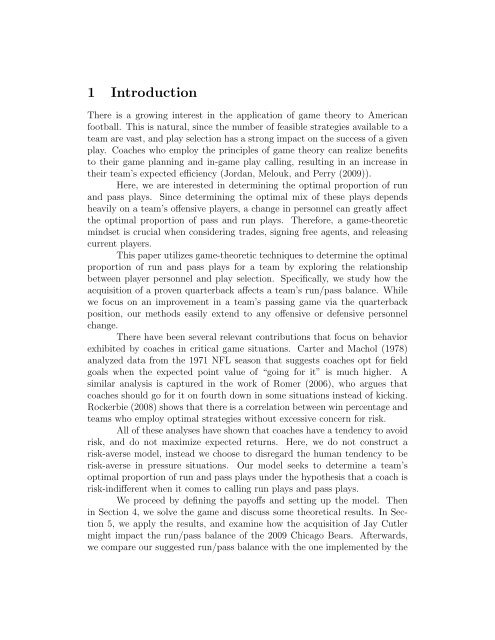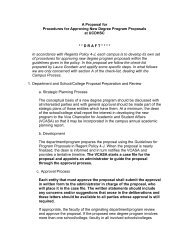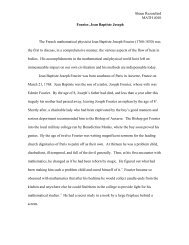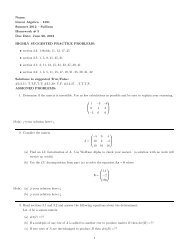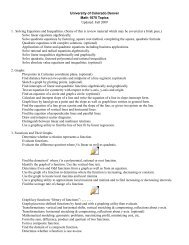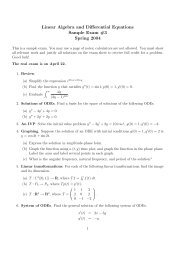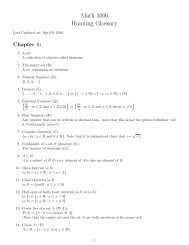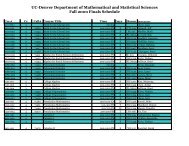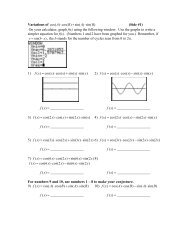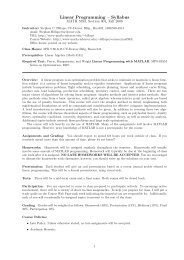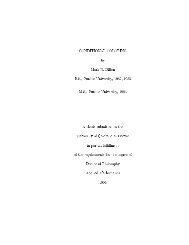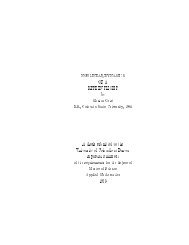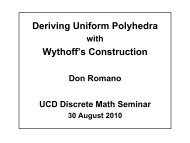A Game-Theoretic Approach to Personnel Decisions in American ...
A Game-Theoretic Approach to Personnel Decisions in American ...
A Game-Theoretic Approach to Personnel Decisions in American ...
You also want an ePaper? Increase the reach of your titles
YUMPU automatically turns print PDFs into web optimized ePapers that Google loves.
1 Introduction<br />
There is a grow<strong>in</strong>g <strong>in</strong>terest <strong>in</strong> the application of game theory <strong>to</strong> <strong>American</strong><br />
football. This is natural, s<strong>in</strong>ce the number of feasible strategies available <strong>to</strong> a<br />
team are vast, and play selection has a strong impact on the success of a given<br />
play. Coaches who employ the pr<strong>in</strong>ciples of game theory can realize benefits<br />
<strong>to</strong> their game plann<strong>in</strong>g and <strong>in</strong>-game play call<strong>in</strong>g, result<strong>in</strong>g <strong>in</strong> an <strong>in</strong>crease <strong>in</strong><br />
their team’s expected efficiency (Jordan, Melouk, and Perry (2009)).<br />
Here, we are <strong>in</strong>terested <strong>in</strong> determ<strong>in</strong><strong>in</strong>g the optimal proportion of run<br />
and pass plays. S<strong>in</strong>ce determ<strong>in</strong><strong>in</strong>g the optimal mix of these plays depends<br />
heavily on a team’s offensive players, a change <strong>in</strong> personnel can greatly affect<br />
the optimal proportion of pass and run plays. Therefore, a game-theoretic<br />
m<strong>in</strong>dset is crucial when consider<strong>in</strong>g trades, sign<strong>in</strong>g free agents, and releas<strong>in</strong>g<br />
current players.<br />
This paper utilizes game-theoretic techniques <strong>to</strong> determ<strong>in</strong>e the optimal<br />
proportion of run and pass plays for a team by explor<strong>in</strong>g the relationship<br />
between player personnel and play selection. Specifically, we study how the<br />
acquisition of a proven quarterback affects a team’s run/pass balance. While<br />
we focus on an improvement <strong>in</strong> a team’s pass<strong>in</strong>g game via the quarterback<br />
position, our methods easily extend <strong>to</strong> any offensive or defensive personnel<br />
change.<br />
There have been several relevant contributions that focus on behavior<br />
exhibited by coaches <strong>in</strong> critical game situations. Carter and Machol (1978)<br />
analyzed data from the 1971 NFL season that suggests coaches opt for field<br />
goals when the expected po<strong>in</strong>t value of “go<strong>in</strong>g for it” is much higher. A<br />
similar analysis is captured <strong>in</strong> the work of Romer (2006), who argues that<br />
coaches should go for it on fourth down <strong>in</strong> some situations <strong>in</strong>stead of kick<strong>in</strong>g.<br />
Rockerbie (2008) shows that there is a correlation between w<strong>in</strong> percentage and<br />
teams who employ optimal strategies without excessive concern for risk.<br />
All of these analyses have shown that coaches have a tendency <strong>to</strong> avoid<br />
risk, and do not maximize expected returns. Here, we do not construct a<br />
risk-averse model, <strong>in</strong>stead we choose <strong>to</strong> disregard the human tendency <strong>to</strong> be<br />
risk-averse <strong>in</strong> pressure situations. Our model seeks <strong>to</strong> determ<strong>in</strong>e a team’s<br />
optimal proportion of run and pass plays under the hypothesis that a coach is<br />
risk-<strong>in</strong>different when it comes <strong>to</strong> call<strong>in</strong>g run plays and pass plays.<br />
We proceed by def<strong>in</strong><strong>in</strong>g the payoffs and sett<strong>in</strong>g up the model. Then<br />
<strong>in</strong> Section 4, we solve the game and discuss some theoretical results. In Section<br />
5, we apply the results, and exam<strong>in</strong>e how the acquisition of Jay Cutler<br />
might impact the run/pass balance of the 2009 Chicago Bears. Afterwards,<br />
we compare our suggested run/pass balance with the one implemented by the
Chicago Bears this past season and some implications due <strong>to</strong> this comparison.<br />
2 Sett<strong>in</strong>g Up the <strong>Game</strong><br />
We consider two-by-two zero-sum games where the offense either runs or passes<br />
and the defense either defends aga<strong>in</strong>st the run or defends aga<strong>in</strong>st the pass.<br />
Each payoff represents an expected ga<strong>in</strong> for the offense under the given strategic<br />
situation. For any serious football team, it is reasonable <strong>to</strong> suggest that<br />
the payoffs can be found, s<strong>in</strong>ce every coach<strong>in</strong>g staff spends much of their time<br />
break<strong>in</strong>g down film.<br />
Table 1: Initial Payoffs<br />
Defense<br />
Defend Run Defend Pass<br />
Offense Run ar,r ar,p<br />
Pass ap,r ap,p<br />
Let the offensive and defensive strategy sets be {R,P } and {DR,DP },<br />
respectively. Furthermore, let ar,r denote the payoff for (R,DR), ar,p denote<br />
the payoff for (R,DP), and so on, as <strong>in</strong> Table 1. Throughout this paper, we<br />
make the reasonable assumptions that ar,r < ap,r and ar,p > ap,p.<br />
We calculate the expected ga<strong>in</strong> for the offensive team <strong>in</strong> a straightforward<br />
manner, save that we adopt a convention used by Alamar (2006) and<br />
Rockerbie (2008) and deduct 45 yards from a team’s <strong>to</strong>tal yardage for each<br />
fumble and <strong>in</strong>terception. For <strong>in</strong>stance, <strong>to</strong> determ<strong>in</strong>e ar,r, suppose that there<br />
were nr,r observed plays <strong>in</strong> which the offense elected <strong>to</strong> run and the defense<br />
elected <strong>to</strong> defend the run, amount<strong>in</strong>g <strong>in</strong> a <strong>to</strong>tal of yr,r yards and tr,r turnovers.<br />
Then<br />
ar,r = yr,r − 45tr,r<br />
.<br />
The rema<strong>in</strong><strong>in</strong>g payoffs <strong>in</strong> Table 1 are calculated <strong>in</strong> a similar manner.<br />
nr,r<br />
3 The Improvement <strong>in</strong> Pass<strong>in</strong>g Model<br />
Hav<strong>in</strong>g demonstrated how <strong>to</strong> calculate the payoffs for our team prior <strong>to</strong> the<br />
relevant personnel change, we now model the impact of this personnel change
on our team’s performance. We assume that the team has acquired a proven<br />
quarterback whose presence will improve all aspects of the pass<strong>in</strong>g game. This<br />
will be reflected <strong>in</strong> our payoff table via an <strong>in</strong>crease <strong>in</strong> both payoff entries<br />
associated with an offensive pass<strong>in</strong>g play.<br />
The follow<strong>in</strong>g additional assumption is a critical part of our model. It<br />
is a common belief that the success of the pass<strong>in</strong>g game is <strong>in</strong>tertw<strong>in</strong>ed with the<br />
success of the runn<strong>in</strong>g game. Consequently, we suppose that the <strong>in</strong>crease <strong>in</strong><br />
expected ga<strong>in</strong>s through pass<strong>in</strong>g will also have a positive effect on the runn<strong>in</strong>g<br />
payoffs ar,r and ar,p. Although the quarterback will positively <strong>in</strong>fluence the<br />
runn<strong>in</strong>g game, he will have a greater impact on the pass<strong>in</strong>g game. This is<br />
because production <strong>in</strong> the pass<strong>in</strong>g game rests squarely upon his ability and<br />
performance, whereas the quarterback’s <strong>in</strong>fluence is generally limited <strong>in</strong> the<br />
runn<strong>in</strong>g game. We now <strong>in</strong>troduce the model.<br />
Throughout this analysis, we assume that the payoff matrix depicted<br />
<strong>in</strong> Table 1 conta<strong>in</strong>s no dom<strong>in</strong>ant rows and no dom<strong>in</strong>ant columns, imply<strong>in</strong>g<br />
that our games will have only mixed strategy Nash equilibria (Nash (1951)).<br />
This assumption is reasonable <strong>in</strong> the context of our desired applications, as<br />
it is unlikely that a serious amateur or professional football team would ever<br />
utilize a pure offensive strategy.<br />
We let x represent the proportional <strong>in</strong>crease <strong>in</strong> the pass<strong>in</strong>g game for<br />
some real x > 0 and let δ measure the residual effect of the improved pass<strong>in</strong>g<br />
game on the runn<strong>in</strong>g game. We conceptualize x as a (relative) quarterback<br />
rat<strong>in</strong>g, so that if x = 0, the new quarterback is no better than the previous one.<br />
These parameters are <strong>in</strong>corporated <strong>in</strong><strong>to</strong> the payoffs from Table 1 <strong>to</strong> obta<strong>in</strong> the<br />
2-by-2 game <strong>in</strong> 2, which reflects the assumed changes <strong>in</strong> player personnel. We<br />
refer <strong>to</strong> this as the improvement <strong>in</strong> pass<strong>in</strong>g model .<br />
Defense<br />
Defend Run Defend Pass<br />
Offense Run ar,r(1 + δx) ar,p(1 + δx)<br />
Pass ap,r(1 + x) ap,p(1 + x)<br />
Table 2: The Improvement <strong>in</strong> Pass<strong>in</strong>g Model<br />
Compar<strong>in</strong>g mobile quarterbacks and pocket passers of the same caliber,<br />
it is reasonable <strong>to</strong> suggest that mobile quarterbacks have a higher δ value,<br />
s<strong>in</strong>ce they are contribut<strong>in</strong>g <strong>to</strong> both phases of the game. In the case of a highly<br />
immobile quarterback with a strong arm, the value of δ for each quarterback<br />
could, <strong>in</strong> fact, be negative, even if x is relatively high. While this is feasible,
and the model is readily adaptable <strong>to</strong> accommodate this possibility, we will<br />
assume for simplicity that δ ∈ [0, 1].<br />
In our simulations, we generally suppose that δ = 1,<br />
although we un-<br />
2<br />
dertake an exam<strong>in</strong>ation of our results for a number of values of δ <strong>in</strong> Section<br />
6. It is important <strong>to</strong> mention that each quarterback corresponds <strong>to</strong> exactly<br />
one x rat<strong>in</strong>g. While this rat<strong>in</strong>g may <strong>in</strong>crease or decrease over the course of a<br />
player’s career, at any given moment it is fixed.<br />
4 Solv<strong>in</strong>g the Model<br />
We solve the improvement <strong>in</strong> pass<strong>in</strong>g model analytically and determ<strong>in</strong>e Nash<br />
equilibria for the proportion of run (and pass) plays depend<strong>in</strong>g on x,δ and the<br />
values <strong>in</strong> Table 1.<br />
First, assume that both the offense and defense are play<strong>in</strong>g optimally.<br />
Let pr be the probability that the offense calls a runn<strong>in</strong>g play. The Nash equilibrium<br />
value for the proportion of runn<strong>in</strong>g plays will arise when the defensive<br />
team is strategy-<strong>in</strong>different. That is, a Nash equilibrium occurs when the<br />
expected value of the “Defend Run” and “Defend Pass” strategies are equal<br />
under the assumption that on each play the offensive coach elects <strong>to</strong> run the<br />
ball <strong>in</strong>dependently with probability pr. Then R(δ,x), the Nash equilibrium<br />
value for the proportion of runn<strong>in</strong>g plays, is the value of pr that solves the<br />
follow<strong>in</strong>g equation:<br />
ar,r(1 + δx)pr + ap,r(1 + x)(1 − pr) = ar,p(1 + δx)pr + (1 + x)ap,p(1 − pr). (1)<br />
After some elementary algebra, we obta<strong>in</strong><br />
R(δ,x) =<br />
(ap,r − ap,p)(1 + x)<br />
. (2)<br />
(ar,p − ar,r)(1 + δx) + (ap,r − ap,p)(1 + x)<br />
Observe that R(δ,x) depends on the quantities (ar,p − ar,r) and (ap,r −<br />
ap,p). These terms measure the benefit of a runn<strong>in</strong>g or pass<strong>in</strong>g play, respectively,<br />
carried out aga<strong>in</strong>st the “wrong” defense. For <strong>in</strong>stance, if (ar,p − ar,r)<br />
is large relative <strong>to</strong> (ap,r − ap,p), then there is more added benefit for a team<br />
<strong>to</strong> run aga<strong>in</strong>st a pass defense than it is <strong>to</strong> pass aga<strong>in</strong>st a run defense (relative<br />
<strong>to</strong> each play be<strong>in</strong>g carried out aga<strong>in</strong>st an appropriate defense). Interest<strong>in</strong>gly,<br />
and somewhat counter<strong>in</strong>tuitively, this bonus for a team <strong>to</strong> “guess right” with<br />
a runn<strong>in</strong>g play results <strong>in</strong> a smaller overall proportion of runn<strong>in</strong>g plays be<strong>in</strong>g<br />
called.
As a notational convenience, let<br />
D(δ,x) = (ar,p − ar,r)(1 + δx) + (ap,r − ap,p)(1 + x).<br />
To f<strong>in</strong>d the defensive Nash equilibrium functions, we perform a similar calculation<br />
<strong>to</strong> that used <strong>to</strong> obta<strong>in</strong> (2). The defensive Nash equilibrium functions<br />
are<br />
Rdef(δ,x) = (ar,p<br />
and<br />
− ap,p) + x(δar,p − ap,p)<br />
D<br />
(3)<br />
Pdef(δ,x) = 1 − Rdef(δ,x) (4)<br />
where Rdef(δ,x) and Pdef(δ,x) denote the Nash equilibrium proportions for<br />
run defense and pass defense, respectively.<br />
These equilibria provide optimal mixed strategy solutions <strong>to</strong> the game<br />
<strong>in</strong> terms of x and δ. We limit x <strong>to</strong> the closed <strong>in</strong>terval [0, 1], because large values<br />
of x result <strong>in</strong> unreasonable <strong>in</strong>creases <strong>in</strong> the expected yards per play, even for<br />
reasonable choices of ar,r, ar,p, ap,r, and ap,p. We feel that the assumption<br />
that a new quarterback will at most double the pass<strong>in</strong>g efficiency of a team is<br />
reasonable, and aga<strong>in</strong> the model is readily adaptable.<br />
Next, note that s<strong>in</strong>ce (1+x) > (1+δx), there may exist some x0 ∈ (0, 1]<br />
such that the pass<strong>in</strong>g row <strong>in</strong> Table 2 will be dom<strong>in</strong>ant for all x ≥ x0. We refer<br />
<strong>to</strong> this value as the break<strong>in</strong>g po<strong>in</strong>t of the model, s<strong>in</strong>ce it is the po<strong>in</strong>t where the<br />
offense would logically transition <strong>to</strong> a pure strategy. We note that break<strong>in</strong>g<br />
po<strong>in</strong>ts do not always exist <strong>in</strong> (0, 1], and <strong>in</strong> these cases, the game is a mixed<br />
strategy game for all x ∈ (0, 1]. In fact, we put forth that the presence of<br />
a break<strong>in</strong>g po<strong>in</strong>t <strong>in</strong> our model provides a reasonable bound on the value of<br />
x, as it does not seem realistic that new player personnel would lead a team<br />
<strong>to</strong> completely abandon the runn<strong>in</strong>g game, even if this may be called for <strong>in</strong> a<br />
narrow set of game situations.<br />
However, <strong>in</strong> the case that a break<strong>in</strong>g po<strong>in</strong>t does exist <strong>in</strong> (0, 1], the<br />
follow<strong>in</strong>g development is necessary for completeness. Recall that we assume<br />
ar,r < ap,r and ar,p > ap,p. Under these assumptions, the break<strong>in</strong>g po<strong>in</strong>t<br />
is easily computed as the value of x satisfy<strong>in</strong>g the equation ap,p(1 + x) =<br />
ar,p(1 + δx). The follow<strong>in</strong>g proposition reflects this.<br />
Proposition 1 If ar,r < ap,r and ar,p > ap,p, then the break<strong>in</strong>g po<strong>in</strong>t of the<br />
game given <strong>in</strong> Table 2 is<br />
(ar,p − ap,p)<br />
(ap,p − δar,p) .
Thus, the break<strong>in</strong>g po<strong>in</strong>t is a function of δ and the <strong>in</strong>itial payoffs. As one<br />
would expect, the offense and defense converge <strong>to</strong> a pure strategy at the break<strong>in</strong>g<br />
po<strong>in</strong>t, as evidenced by the fact that Pdef(δ, (ar,p−ap,p) (ar,p−ap,p)<br />
) = P(δ, ) =<br />
(ap,p−δar,p) (ap,p−δar,p)<br />
1. To account for the defensive change from a mixed strategy <strong>to</strong> a pure strategy<br />
at the break<strong>in</strong>g po<strong>in</strong>t, we give the follow<strong>in</strong>g discont<strong>in</strong>uous Nash equilibrium<br />
runn<strong>in</strong>g function when x ≥ 0.<br />
R ∗ ⎧ (ap,r−ap,p)(1+x)<br />
⎨ D<br />
(δ,x) =<br />
⎩<br />
0 otherwise.<br />
0 ≤ x < (ar,p−ap,p)<br />
(ap,p−ar,pδ) ,<br />
Similarly, we def<strong>in</strong>e the discont<strong>in</strong>uous Nash equilibrium pass<strong>in</strong>g function<br />
<strong>to</strong> be P ∗ (δ,x) = 1 − R ∗ (δ,x). The runn<strong>in</strong>g function R ∗ encompasses the<br />
above discussion that there is a mixed strategy solution prior <strong>to</strong> the break<strong>in</strong>g<br />
po<strong>in</strong>t, and that after the break<strong>in</strong>g po<strong>in</strong>t has been reached, quarterback play<br />
has become so <strong>in</strong>fluential that the offense only passes.<br />
Next, we calculate V , the value of the game expressed <strong>in</strong> Table 2. If x<br />
is past the break<strong>in</strong>g po<strong>in</strong>t, then V = ap,p(1 + x), as both teams pursue a pure<br />
strategy. Otherwise, we simply evaluate either side of Equation (1) at R(δ,x).<br />
After simplify<strong>in</strong>g, we obta<strong>in</strong> the follow<strong>in</strong>g expression for the value of the game<br />
V (δ,x) = (1 + δx)(1 + x)(ar,pap,r − ap,par,r)<br />
. (6)<br />
D<br />
Observe that (ar,pap,r − ap,par,r) = 0 s<strong>in</strong>ce the payoff matrix A has no<br />
dom<strong>in</strong>ant rows or columns, and hence its rows and columns are necessarily<br />
l<strong>in</strong>early <strong>in</strong>dependent. S<strong>in</strong>ce V depends on the nature of the game, it is likely a<br />
discont<strong>in</strong>uous function of x at the break<strong>in</strong>g po<strong>in</strong>t. Under our assumption that<br />
ap,r > ap,p we obta<strong>in</strong> the follow<strong>in</strong>g expression for the value of the game when<br />
x ≥ 0.<br />
V ∗ ⎧ (1+δx)(1+x)(ar,pap,r−ap,par,r)<br />
⎨<br />
D<br />
(δ,x) =<br />
⎩<br />
ap,p(1 + x) otherwise.<br />
0 ≤ x < (ar,p−ap,p)<br />
(ap,p−δar,p) ,<br />
Before we proceed with our predictive example, we exam<strong>in</strong>e an <strong>in</strong>terest<strong>in</strong>g<br />
and unexpected property of R ∗ . For values of x less than the break<strong>in</strong>g<br />
po<strong>in</strong>t, we observe that<br />
(5)<br />
(7)
∂R∗ ∂x = (ar,p − ar,r)(ap,r − ap,p)(1 − δ)<br />
D2 . (8)<br />
Our assumption about the <strong>in</strong>itial payoffs, specifically that ar,p > ar,r<br />
and ap,r > ap,p imply that ∂R∗ > 0. This is quite unexpected, as it suggests<br />
∂x<br />
that as a team’s pass<strong>in</strong>g game improves, the team should actually pass less<br />
than it did previously!<br />
5 Predict<strong>in</strong>g the Impact of Jay Cutler on the<br />
Play Selection of the 2009 Chicago Bears<br />
In this section, we utilize our model <strong>to</strong> make a prediction relevant <strong>to</strong> the 2009<br />
NFL season by consider<strong>in</strong>g the effect of new quarterback Jay Cutler on the<br />
play selection of the Chicago Bears. Recall that <strong>to</strong> f<strong>in</strong>d the payoffs for Table<br />
1 <strong>in</strong> the manner described above, the defensive strategies “Defend Run” and<br />
“Defend Pass” must be clearly def<strong>in</strong>ed and the number of times each strategy<br />
is employed must be accurately tallied. In our computational analysis below,<br />
we utilize data from past NFL seasons, but we do not explicitly determ<strong>in</strong>e<br />
the number of times the defense chose each strategy. Instead, we attempt <strong>to</strong><br />
approximate these values. While this is not optimal, we aga<strong>in</strong> po<strong>in</strong>t out that<br />
a serious team’s coach<strong>in</strong>g staff would have ready access <strong>to</strong> the necessary data.<br />
In his fourth NFL season, Jay Cutler is among the more promis<strong>in</strong>g<br />
young quarterbacks <strong>in</strong> the league. In the 2008 season, he f<strong>in</strong>ished 3 rd <strong>in</strong> the<br />
NFL <strong>in</strong> <strong>to</strong>tal pass<strong>in</strong>g yardage and was subsequently traded from Denver <strong>to</strong><br />
Chicago. For Bears fans, this is good news, s<strong>in</strong>ce <strong>in</strong> the past five seasons the<br />
Chicago Bears have f<strong>in</strong>ished no better than 14 th <strong>in</strong> the NFL <strong>in</strong> <strong>to</strong>tal pass<strong>in</strong>g<br />
yardage. With an improvement <strong>in</strong> pass<strong>in</strong>g, Chicago figured <strong>to</strong> be competitive<br />
<strong>in</strong> the NFC. The follow<strong>in</strong>g analysis aims <strong>to</strong> exam<strong>in</strong>e how the acquisition of<br />
Jay Cutler might alter the run/pass balance of the Chicago Bears for the 2009<br />
season.<br />
We first construct the payoff matrix for the Chicago Bears us<strong>in</strong>g empirical<br />
data from the 2008 season. This data determ<strong>in</strong>es the values of the <strong>in</strong>itial<br />
payoffs for the improvement <strong>in</strong> pass<strong>in</strong>g model, as outl<strong>in</strong>ed <strong>in</strong> Section 3. Then,<br />
<strong>to</strong> predict how the mixed strategies change for Chicago, we explore how Jay<br />
Cutler <strong>in</strong>fluenced the expected yardage per play <strong>in</strong> his first season as a starter<br />
<strong>in</strong> Denver. Once this <strong>in</strong>fluence is known, we project it on<strong>to</strong> the 2009 Chicago<br />
Bears improvement <strong>in</strong> pass<strong>in</strong>g model.
To calculate the <strong>in</strong>itial payoffs, as <strong>in</strong> Table 1, we consider the data <strong>in</strong> Table<br />
3 on the 2008 Chicago Bears offense, obta<strong>in</strong>ed from http://www.NFL.com<br />
(NFL (2009)).<br />
Rush<strong>in</strong>g Pass<strong>in</strong>g Total<br />
Yards 1673 3061 4734<br />
Plays 434 557 991<br />
Expected Value 2.92 4.36 3.73<br />
Percentage of Plays 44 56 100<br />
Table 3: The 2008 Chicago Bears Offense<br />
To f<strong>in</strong>d the payoffs, we assume that NFL defenses know how often<br />
Chicago runs and passes, and that when they play Chicago, they defend the<br />
run and pass equally as often. Then we know from Table 3 that the follow<strong>in</strong>g<br />
approximate equations hold<br />
.44ar,r + .56ar,p = 2.92 (9)<br />
.44ap,r + .56ap,p = 4.36.<br />
To understand how an improvement <strong>in</strong> the pass<strong>in</strong>g game will affect<br />
the current play selection ratio of the Chicago Bears, we consider the effect<br />
of the Bears utiliz<strong>in</strong>g their optimal mixed strategy. Also, we assume that<br />
the overall expected value of defend<strong>in</strong>g the run is the same as the expected<br />
value of defend<strong>in</strong>g the pass. This is reasonable, s<strong>in</strong>ce there exist run defenses<br />
that match up well aga<strong>in</strong>st certa<strong>in</strong> types of pass plays and pass defenses that<br />
match-up well aga<strong>in</strong>st certa<strong>in</strong> types of run plays. This assumption yields the<br />
equation<br />
.44(ar,r − ar,p) + .56(ap,r − ap,p) = 0. (10)<br />
Comb<strong>in</strong><strong>in</strong>g equations (9) and (10) produces a dependent system of three equations<br />
<strong>in</strong> four unknowns. We select ap,p as the free variable. Solv<strong>in</strong>g these<br />
equations we f<strong>in</strong>d<br />
<br />
1.65ap,p − 4.26 −1.28ap,p + 8.52<br />
A =<br />
−1.28ap,p + 9.96 ap,p<br />
<br />
. (11)<br />
S<strong>in</strong>ce we assume the defense plays a mixed strategy, the offensive strategy<br />
must also be mixed. Therefore, we will select ap,p so that A has no dom<strong>in</strong>ant<br />
rows and no dom<strong>in</strong>ant columns. This implies, via a straightforward calculation<br />
(available <strong>in</strong> McGough (2009)), that we must choose ap,p ∈ [2.59, 4.36]
<strong>in</strong> order <strong>to</strong> produce our desired payoff structure: ap,p < ap,r, ar,p > ap,p,<br />
ar,r < ar,p, and ar,r < ap,r.<br />
For our analysis we choose ap,p = 10,<br />
as an offense strives <strong>to</strong> achieve<br />
3<br />
at least 10 yards on first through third down and the defense wishes <strong>to</strong> hold<br />
3<br />
them <strong>to</strong> at most this average. This gives<br />
<br />
1.23 4.26<br />
A ≈<br />
5.70 3.33<br />
and leads <strong>to</strong> Table 4, the improvement <strong>in</strong> pass<strong>in</strong>g model for the 2009 Bears.<br />
Defense<br />
Defend Run Defend Pass<br />
Offense Run 1.23(1 + δx) 4.26(1 + δx)<br />
Pass 5.70(1 + x) 3.33(1 + x)<br />
Table 4: The 2009 Chicago Bears Improvement <strong>in</strong> Pass<strong>in</strong>g Model<br />
Table 5 gives optimal solutions <strong>to</strong> the game for selected values of x with<br />
δ = 1<br />
2 . Note that when x = 0, R∗ and V represent the proportion of run plays<br />
and the average yards per play, respectively, for the Bears <strong>in</strong> 2008.<br />
x 0 0.1 0.2 0.3 0.4<br />
R ∗ 0.439 0.450 0.460 0.469 0.477<br />
∂R ∗<br />
∂x 0.123 0.107 0.094 0.083 0.074<br />
P ∗ 0.561 0.550 0.540 0.531 0.523<br />
V 3.738 4.023 4.313 4.596 4.877<br />
Table 5: Optimal Play Balance and Expected Yardage for the 2009 Chicago<br />
Bears<br />
Observe that <strong>in</strong> Table 5, the number of runn<strong>in</strong>g plays called <strong>in</strong>creases<br />
as x grows and the pass<strong>in</strong>g game improves. This reflects our observations <strong>in</strong><br />
the previous section. As mentioned above, our calculations will generally use<br />
δ = 1<br />
2 . Figure 1 gives the values of R∗ (δ,x) for all δ and x <strong>in</strong> [0, 1]. The<br />
greyscale <strong>to</strong> the right of the figure gives a measure of R ∗ , with lighter shades<br />
reflect<strong>in</strong>g a higher proportion of runn<strong>in</strong>g plays. For a given δ, the black region<br />
<strong>in</strong> the figure represents those values of x beyond the break<strong>in</strong>g po<strong>in</strong>t.
δ<br />
1<br />
0.9<br />
0.8<br />
0.7<br />
0.6<br />
0.5<br />
0.4<br />
0.3<br />
0.2<br />
0.1<br />
R* Color<strong>in</strong>g the Unit Square<br />
0<br />
0 0.2 0.4 0.6 0.8 1<br />
x<br />
Figure 1: R ∗ (δ,x) us<strong>in</strong>g 2008 Chicago Bears Data<br />
As can be seen <strong>in</strong> Figure 1, the break<strong>in</strong>g po<strong>in</strong>t when δ = 1 (as <strong>in</strong> 2<br />
our calculations) is approximately 0.775. This implies that <strong>to</strong> be justified<br />
<strong>in</strong> play<strong>in</strong>g a pure pass strategy, the expected yards per play would have <strong>to</strong><br />
<strong>in</strong>crease by approximately 2.178 yards. This is a large <strong>in</strong>crease, and supports<br />
our claim that it is unrealistic <strong>to</strong> anticipate that Chicago would ever pursue a<br />
pure pass<strong>in</strong>g strategy.<br />
In order <strong>to</strong> exam<strong>in</strong>e how Jay Cutler impacts the run/pass balance of<br />
the Chicago Bears, we first f<strong>in</strong>d his x. To do so, we will consider Cutler’s<br />
effect on the Broncos’ offense <strong>in</strong> 2007, his first year as a starter. We beg<strong>in</strong><br />
us<strong>in</strong>g the data from the 2006 Broncos offense <strong>to</strong> calculate Table 6, Denver’s<br />
2007 improvement <strong>in</strong> pass<strong>in</strong>g model, <strong>in</strong> a manner similar <strong>to</strong> our development<br />
of Table 4.<br />
Defense<br />
Defend Run Defend Pass<br />
Offense Run 2.73(1 + δx) 4.25(1 + δx)<br />
Pass 4.86(1 + x) 3.33(1 + x)<br />
Table 6: The 2007 Denver Broncos Improvement <strong>in</strong> Pass<strong>in</strong>g Model<br />
In 2007, the Broncos ga<strong>in</strong>ed an average of 4.57 yards per play. Thus,<br />
the x-value that we seek for Jay Cutler is the solution <strong>to</strong> V ∗ ( 1,x)<br />
= 4.57,<br />
2<br />
where V ∗ is as given <strong>in</strong> (7). Solv<strong>in</strong>g, we obta<strong>in</strong> x ≈ 0.279.<br />
1<br />
0.9<br />
0.8<br />
0.7<br />
0.6<br />
0.5<br />
0.4<br />
0.3<br />
0.2<br />
0.1<br />
0
Therefore, if we assume that Jay Cutler has a similar <strong>in</strong>fluence <strong>in</strong><br />
Chicago <strong>to</strong> the one he had <strong>in</strong> Denver, then substitut<strong>in</strong>g x ≈ 0.279 <strong>in</strong><strong>to</strong> Table<br />
4, the Chicago Bears improvement <strong>in</strong> pass<strong>in</strong>g model, and perform<strong>in</strong>g the necessary<br />
calculations, gives that the Bears should expect an overall <strong>in</strong>crease of<br />
about 0.799 yards per play.<br />
Also, quite <strong>in</strong>terest<strong>in</strong>gly, because of this anticipated improvement <strong>in</strong><br />
pass<strong>in</strong>g, our model <strong>in</strong>dicates that the Bears should call about 3% more runn<strong>in</strong>g<br />
plays this season and implement a 47 : 53 run/pass ratio. While these<br />
results are not overwhelm<strong>in</strong>gly significant, from a coach<strong>in</strong>g standpo<strong>in</strong>t they are<br />
valuable. They suggest that a strong emphasis should be placed on develop<strong>in</strong>g<br />
the runn<strong>in</strong>g game <strong>in</strong> tra<strong>in</strong><strong>in</strong>g camp and dur<strong>in</strong>g the pre-season, s<strong>in</strong>ce it should<br />
be a central focus on Sunday afternoons.<br />
2009 was a season <strong>to</strong> forget for the Chicago Bears. After beg<strong>in</strong>n<strong>in</strong>g the<br />
season 3-1, the Bears f<strong>in</strong>ished the season an abysmal 7-9. The Bears struggled<br />
all season runn<strong>in</strong>g the football and were held <strong>to</strong> an NFC worst 93.2 yards per<br />
game. Meanwhile, some would argue, they rema<strong>in</strong>ed overly committed <strong>to</strong> the<br />
pass<strong>in</strong>g game, call<strong>in</strong>g a pass play 62% of the time. This idea was echoed by<br />
Bears six-time Pro Bowl l<strong>in</strong>ebacker Brian Urlacher who said,“Look, I love Jay,<br />
and I understand he’s a great player who can take us a long way, and I still<br />
have faith <strong>in</strong> him. But I hate the way our identity has changed. We used <strong>to</strong><br />
establish the run and wear teams down and try not <strong>to</strong> make mistakes, and<br />
we’d rely on our defense <strong>to</strong> keep us <strong>in</strong> the game and make big plays <strong>to</strong> put us<br />
<strong>in</strong> position <strong>to</strong> w<strong>in</strong>. Kyle Or<strong>to</strong>n might not be the flashiest quarterback, but the<br />
guy is a w<strong>in</strong>ner, and that formula worked for us. I hate <strong>to</strong> say it, but that’s<br />
the truth (Urlacher (2010)).” In 2008, the Bears’ run/pass ratio was 44 : 56,<br />
ga<strong>in</strong><strong>in</strong>g approximately 3.74 yards per play. In 2009, with the acquisition of<br />
Jay Cutler, the Bears’ run/pass ratio was 38 : 62, ga<strong>in</strong><strong>in</strong>g approximately 3.68<br />
yards per play. Our model suggests that the Bears should have called a run<br />
play about 47% of the time. For our model, their allocation of run and pass<br />
deviates 9% from our result, imply<strong>in</strong>g that the Bears were play<strong>in</strong>g far from<br />
optimally. Although these results do not validate our prediction, they do give<br />
some explanation as <strong>to</strong> why the Bears underachieved <strong>in</strong> 2009.<br />
6 Summary and Extensions<br />
This paper discusses how player personnel changes alter the run/pass balance<br />
of an offense. Our conclusions have far-reach<strong>in</strong>g implications. Quite unexpectedly,<br />
our results suggest that if a team acquires new personnel that will
improve their expected returns <strong>in</strong> pass<strong>in</strong>g, without a correspond<strong>in</strong>g change <strong>to</strong><br />
their runn<strong>in</strong>g personnel, they should pass less than they did a season ago.<br />
This analysis also extends <strong>to</strong> different phases of the game, offensively<br />
and defensively. If a team trades for a lock-down cornerback, the defensive coord<strong>in</strong>a<strong>to</strong>r<br />
should blitz more. If the offense signs a talented runn<strong>in</strong>g back, they<br />
should pass more. This analysis describes the value of players, s<strong>in</strong>ce if a team<br />
signs John Doe, then they are able <strong>to</strong> say “he allots us freedom <strong>in</strong> this way.”<br />
Of course, this can become complicated when a team drafts several players.<br />
However, it is reasonable <strong>to</strong> suppose that there is a positive correlation between<br />
the order <strong>in</strong> which the players are drafted and the immediate utility they<br />
contribute <strong>to</strong> the organization. Thus, given a draft order<strong>in</strong>g of players, and<br />
their comparative strengths and weaknesses, it is possible <strong>to</strong> understand how<br />
the play selection changes on offense and defense us<strong>in</strong>g these game-theoretic<br />
arguments.<br />
We note the limitations of the model. First of all, the choice of δ is ad<br />
hoc, however its presence is unavoidable. The accuracy of the model could be<br />
improved by develop<strong>in</strong>g a more sophisticated relationship between the value<br />
of x and the resultant <strong>in</strong>crease <strong>in</strong> the runn<strong>in</strong>g game. Secondly, the projection<br />
of x, found by exam<strong>in</strong><strong>in</strong>g past Denver Bronco’s data, on<strong>to</strong> the 2008 Chicago<br />
Bears improvement <strong>in</strong> pass<strong>in</strong>g model is debatable. Clearly, the <strong>in</strong>crease <strong>in</strong><br />
expected yardage per play for Denver from the 2006 season <strong>to</strong> the 2007 season<br />
was not due solely <strong>to</strong> Jay Cutler’s production. With that said, it is always true<br />
that a quarterback rat<strong>in</strong>g reflects both the statistical makeup of a quarterback<br />
and the quality of his support<strong>in</strong>g cast. Ideally, the choice of x would reflect<br />
a more complete analysis of the pass<strong>in</strong>g game from year <strong>to</strong> year, <strong>in</strong>volv<strong>in</strong>g<br />
statistical methods <strong>to</strong> analyze a larger collection of players.<br />
F<strong>in</strong>ally, our ultimate vision for this model supports the construction<br />
of a more complete payoff matrix, consist<strong>in</strong>g of a larger number of offensive<br />
and defensive strategies. Ideally, trends, strengths, and weaknesses would be<br />
considered <strong>to</strong> enable an approach that is more adaptable week-by-week. As<br />
difficult as this sounds, it can be done by break<strong>in</strong>g down film of NFL games.<br />
All of these extensions would aid <strong>in</strong> the development of coach<strong>in</strong>g strategy,<br />
which <strong>in</strong> turn, would cause the game <strong>to</strong> evolve.<br />
References<br />
Alamar, B. (2006): “The pass<strong>in</strong>g premium puzzle,” Journal of Quantitative<br />
Analysis <strong>in</strong> Sports, 2(4), Article 5.
Carter, V. and R. Machol (1978): “Optimal strategies on fourth down,” Management<br />
Science, 24(16), 1758–1762.<br />
Jordan, J., S. Melouk, and M. Perry (2009): “Optimiz<strong>in</strong>g football game play<br />
call<strong>in</strong>g,” Journal of Quantitative Analysis <strong>in</strong> Sports, 5(2), Article 2.<br />
McGough, E. (2009): Analyz<strong>in</strong>g the Relationship Between Player <strong>Personnel</strong><br />
and Optimal Mixed Strategies <strong>in</strong> <strong>American</strong> Football, Master’s thesis, The<br />
University of Akron.<br />
Nash, J. (1951): “Non-cooperative games,” Ann. Math., 54, 286–295.<br />
NFL (2009): “Nfl statistics,” World Wide Web electronic publication, URL<br />
http://www.nfl.com.<br />
Rockerbie, D. (2008): “The pass<strong>in</strong>g premium puzzle revisited,” Journal of<br />
Quantitative Analysis <strong>in</strong> Sports, 4(2), Article 5.<br />
Romer, D. (2006): “Do firms maximize? evidence from professional football,”<br />
Journal of Political Economy, 114(2), 340–365.<br />
Urlacher, B. (2010): “Struggles with sidel<strong>in</strong>e role,” World Wide Web electronic<br />
publication, URL http://sports.yahoo.com/nfl/.


